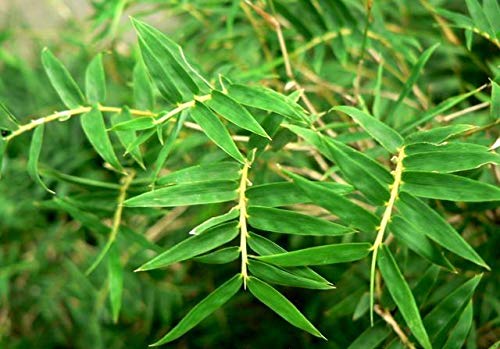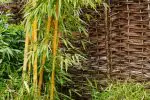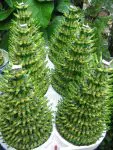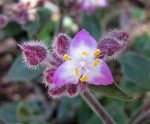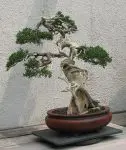This post contains affiliate links. If you buy something from one of our links we may earn a commission. Thanks
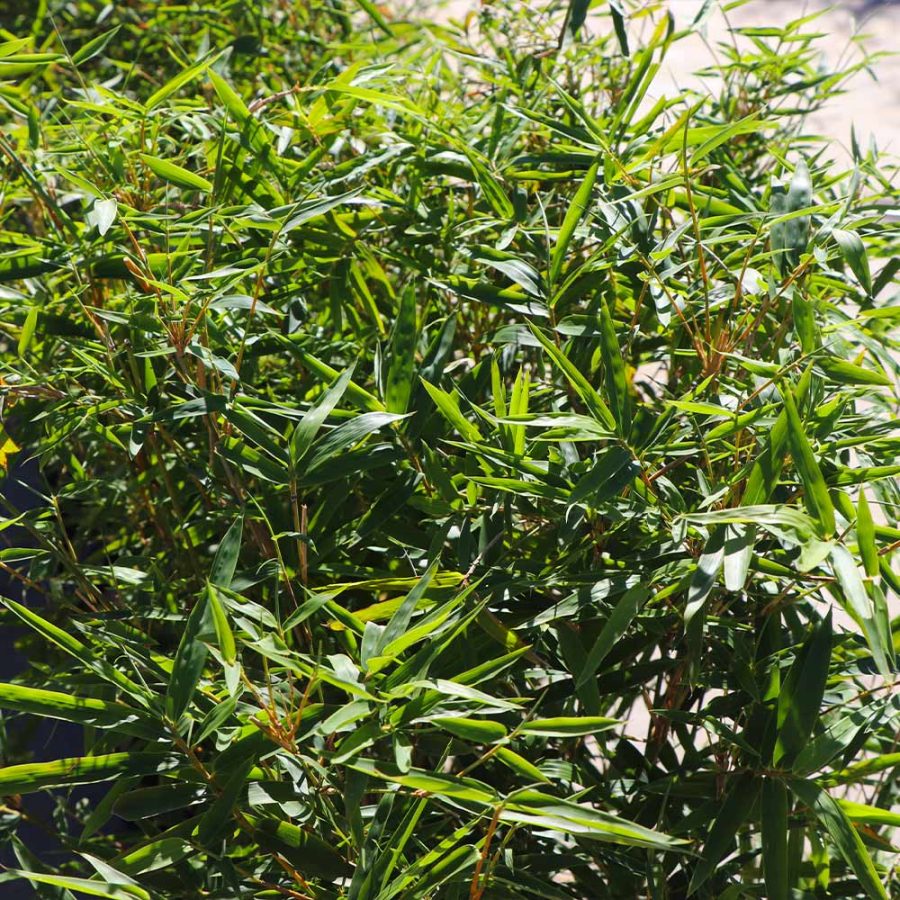
Discover the secrets to keeping your Fernleaf Bamboo happy and thriving indoors! Learn expert tips and tricks for Fernleaf Bamboo indoor care today.
Caring for Fernleaf Bamboo plants involves providing them with well-drained soil and partial to full shade. These plants prefer moist but not waterlogged conditions. A balanced, slow-release fertilizer applied in spring aids in healthy growth. Protect the plant from strong winds and extreme cold for optimal health and appearance.
Are you looking to add a touch of tropical charm to your indoor space? Look no further than Bambusa multiplex ‘Fernleaf’!
With its delicate leaves and graceful stems, this stunning plant is sure to impress.
But to keep it looking its best, you’ll need to master Fernleaf Bamboo Indoor Care. Don’t worry – we’ve got you covered with our expert tips and tricks. Let’s dive in!
Introduction To Fernleaf Bamboo Indoor Care
Hey there plant lovers! Are you on the hunt for a new houseplant to brighten up your living space?
Look no further than Fernleaf Bamboo! Not only is it a stunning addition to any room, but it’s also relatively easy to care for.
However, to ensure your Fernleaf Bamboo thrives, you need to know how to properly care for it indoors.
In this blog post, we’ll give you all the tips and tricks you need to keep your Fernleaf Bamboo healthy and happy. Let’s get started!
An Introduction To Fernleaf Bamboo As A Houseplant
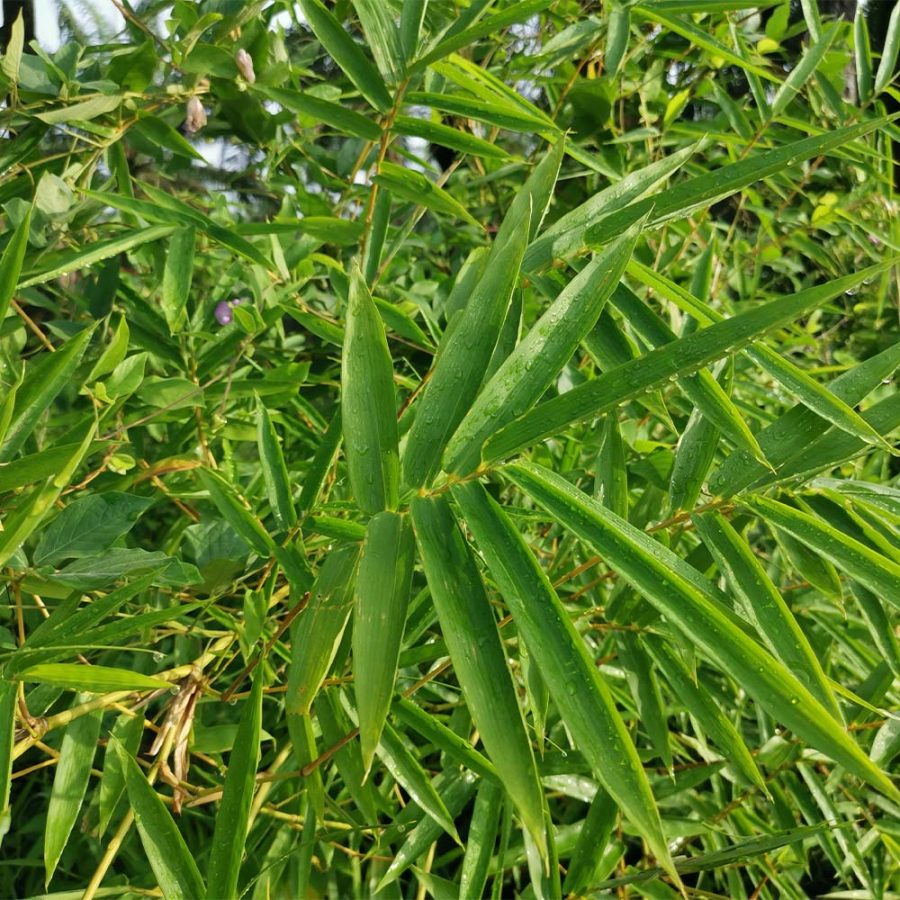
Fernleaf Bamboo, or its botanical name Bambusa multiplex ‘Fernleaf’, is a popular houseplant known for its delicate leaves and graceful stems. It’s a favorite among plant enthusiasts because of its tropical vibe.
Bambusa multiplex is a species of bamboo trees native to Southern China.
Bambusa Multiplex is a beautiful medium-sized bamboo plant that forms a dense clump of slender culms and lush foliage.
Due to its dense growth, it makes a good choice for hedges and live fences, creating an effective barrier that offers privacy and beauty.
Under optimal conditions, the stems can grow up to a maximum height of 10 feet tall, providing an impressive natural screen.
Its compact size also makes it a good choice for growing indoors.
Propagation of Bambusa Multiplex can be done through rhizome offsets or rooted culm cuttings, making it easy for plant enthusiasts to grow and expand their collection.
It grows Well In USDA Zones:7-10 outdoors and is hardy to 10 degrees Fahrenheit.
Fernleaf Bamboo is not invasive like running bamboo. It is a clumping bamboo species that won’t take over your garden if you plant it outside.
It can be used outdoors as a hedge bamboo and a privacy screen.
Black bamboo is a different species and another excellent choice for outdoors and also a great choice for indoor bamboo plants.
If you are growing it in pots the pot itself provides a root barrier to eliminate spreading.
B. The Importance of Proper Care
Although Fernleaf Bamboo is a relatively low-maintenance plant, it still requires proper care to thrive.
By providing the right conditions, you can keep your indoor plants healthy and beautiful for years to come. Here are some essential tips for Fernleaf Bamboo Indoor Care:
Fernleaf Bambo Quick Facts
| Mature Height: | 6-10 ft. |
| Mature Width: | 4-6 ft. |
| Sunlight: | Full-Partial |
| Growth Rate: | Fast |
| Botanical Name: | Bambusa multiplex ‘Fernleaf’ |
| Grows Well In Zones: | 7-10 outdoors |
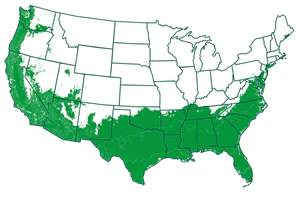
You can get your Fernleaf Bamboo plant here
Fernleaf Bambo Care In A Nutshell
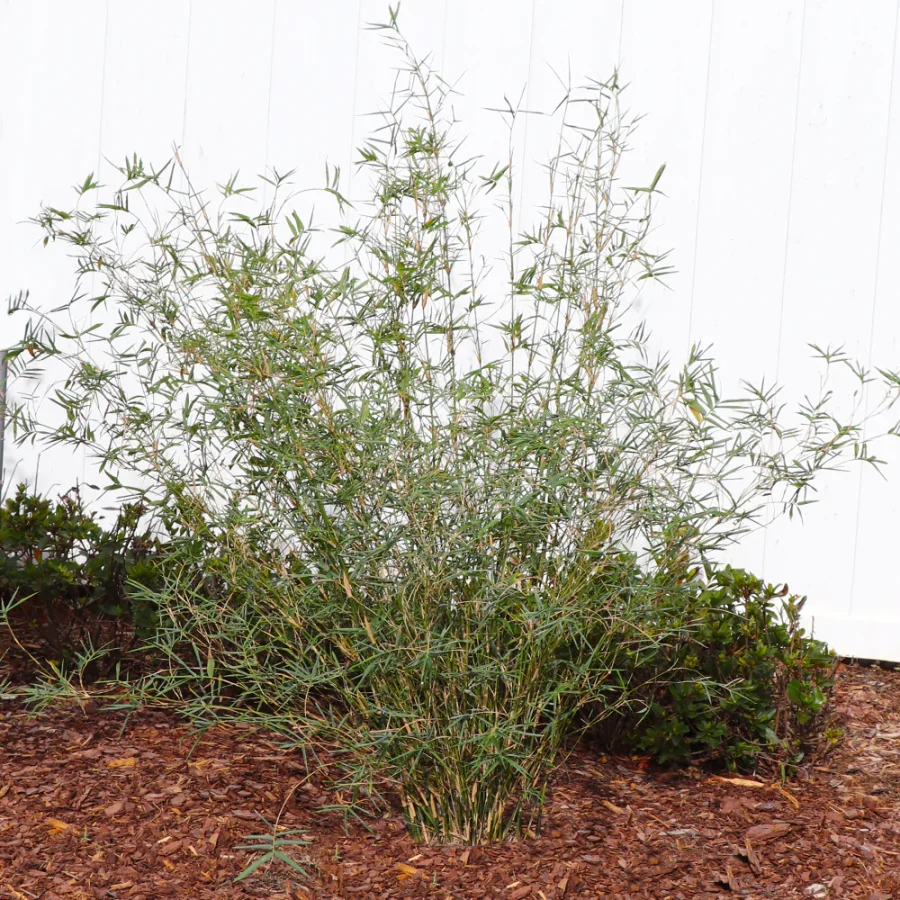
Lighting
Fernleaf Bamboo prefers bright light. Place your plant near a window, with direct sunlight. In the rare case, it can scorch the leaves so move it to partial shade.
Watering
Proper watering is essential to the health of your Fernleaf Bamboo.
It prefers moist soil. The best time to water your plant is when the soil surface feels dry to the touch. Avoid overwatering, as this can lead to root rot.
Temperature and Humidity
Fernleaf Bamboo thrives in moderate temperatures and high humidity levels.
Keep the temperature between 60-80°F and use a humidifier or mist the plant regularly to increase humidity levels.
Soil and Fertilizer
Use a well-draining soil mix for your Fernleaf Bamboo, and fertilize it every 2-4 weeks during the growing season with a balanced fertilizer.
Pruning and Propagation
Prune your Fernleaf Bamboo to remove any damaged or yellowing leaves. It can also be propagated through division.
Recap
Fernleaf Bamboo is a beautiful and unique addition to any indoor space, but it requires proper care to keep it thriving.
By following these essential Fernleaf Bamboo Indoor Care tips, you can ensure your plant stays healthy and beautiful for years to come.
Now let’s go into each of these topics in more detail.
Lighting
When it comes to caring for your Fernleaf Bamboo, lighting is a crucial factor to consider.
Like all plants, Fernleaf Bamboo needs the right amount of light to grow and thrive.
In this section, we’ll discuss the best lighting conditions for your Fernleaf Bamboo and how to ensure it gets the light it needs to flourish. Let’s dive in!
Lighting Needs for Fernleaf Bamboo
Fernleaf Bamboo requires bright light to thrive.
In its native habitat, it grows under the canopy of larger trees, so it’s adapted to lower light levels but it will do best with 4-6 hours of direct full sunlight.
While it can tolerate some shade, it still needs enough sunlight to grow and produce new leaves.
Bright Light
Bright light means placing your Fernleaf Bamboo near a south-facing window with direct sun exposure.
If you don’t have access to natural light, you can use artificial grow lights to provide your plant with the right amount of light.
Direct Sunlight Is Best
It’s essential to expose your Fernleaf Bamboo to direct sunlight.
If you do notice that your plant is getting too much direct sunlight, use sheer curtains to filter the light.
On the other hand if you notice your plant getting leggy or losing color it needs more light.
Recap
Proper lighting is crucial for the health and growth of your Fernleaf Bamboo.
By providing it with bright light and giving it 4-6 hours of direct sunlight, you can ensure your plant stays healthy and beautiful.
In the next section, we’ll discuss how to water your Fernleaf Bamboo correctly.
Watering
Hello, plant enthusiasts! One of the essential aspects of caring for your Fernleaf Bamboo is providing it with the right amount of water.
Overwatering or underwatering can cause significant damage to your plant, so it’s crucial to get this aspect of care just right.
In this section, we’ll cover everything you need to know about watering your Fernleaf Bamboo. So, grab your watering can, and let’s get started!
Proper Watering for Fernleaf Bamboo
Watering your Fernleaf Bamboo correctly is vital to its health and longevity. While it requires regular watering don’t overwater it. The right amount of water keeps the plant hydrated, but overwatering can lead to root rot and other issues. In this section, we’ll discuss how to properly water your Fernleaf Bamboo.
Avoid Overwatering
The most common mistake people make when caring for their Fernleaf Bamboo is overwatering.
To avoid this, water your plant when the top inch of soil feels dry to the touch.
Allow the water to drain through the soil and out the drainage holes at the bottom of the pot.
Make sure to discard any excess water that remains in the saucer.
Allow Soil to Dry Out
Fernleaf Bamboo prefers well-draining soil that allows excess water to drain away quickly.
Allowing the soil to dry out between waterings helps prevent overwatering and keeps your plant healthy.
However, be careful not to let the soil dry out completely, as this can cause the leaves to yellow and drop.
Use Filtered or Distilled Water
Fernleaf Bamboo is sensitive to minerals found in tap water, such as chlorine and fluoride.
Using filtered or distilled water can prevent mineral buildup in the soil and keep your plant healthy.
If you don’t have access to filtered or distilled water, you can also use rainwater.
Watering Conclusion
Proper watering is essential for the health of your Fernleaf Bamboo.
Avoid overwatering, allow the soil to dry out between waterings, and use filtered or distilled water to prevent mineral buildup.
In the next section, we’ll discuss the ideal temperature and humidity levels for your Fernleaf Bamboo.
Temperature and Humidity
Temperature and humidity are crucial factors in creating the perfect environment for your Fernleaf Bamboo.
While it’s adaptable to a range of conditions, maintaining the ideal temperature and humidity levels can help your plant thrive and stay healthy.
In this section, we’ll dive into the specifics of what temperature and humidity levels your Fernleaf Bamboo prefers and how to ensure it’s getting the right conditions.
Let’s get started!
Ideal Temperature Range for Fernleaf Bamboo
Fernleaf Bamboo is a tropical plant that thrives in warm climates and humid environments.
Outdoors it can survive cold temperatures as low as 10 degrees but while it can tolerate a range of temperatures, it prefers to be kept in a temperature range between 65-85°F (18-29°C).
Avoid exposing your Fernleaf Bamboo to extreme temperatures below 55°F (12°C) or above 90°F (32°C).
Moderate to High Humidity Levels
In addition to the right temperature, Fernleaf Bamboo also requires moderate to high humidity levels to thrive.
The ideal humidity level for your Fernleaf Bamboo is between 50-70%.
Low humidity can cause the leaves to dry out and turn brown, while high humidity levels can lead to fungal growth.
How to Increase Humidity
If you live in a dry climate or during the winter months when indoor heating can dry out the air, you may need to increase the humidity levels around your Fernleaf Bamboo.
A great way to do this is to use a humidifier. If you don’t have a humidifier, you can mist your plant regularly with water.
Another option is to place a pebble tray or a tray of water near your Fernleaf Bamboo, allowing the water to evaporate and increase the humidity levels around the plant.
Recap
Maintaining the ideal temperature and humidity levels for your Fernleaf Bamboo is crucial to its overall health and well-being.
Keep the temperature between 65-85°F (18-29°C) and humidity levels between 50-70%.
Use a humidifier, or mist regularly, or place a tray of water near your plant to increase humidity levels. In the next section, we’ll discuss fertilizing your Fernleaf Bamboo.
Soil and Fertilizer
Hey there, plant enthusiasts! One of the keys to a thriving Fernleaf Bamboo is ensuring it has the right soil and regular fertilization.
In this section, we’ll cover what soil type Fernleaf Bamboo prefers, how to fertilize it properly, and some tips to keep your plant healthy and happy.
Let’s get started!
Ideal Soil Mix for Fernleaf Bamboo
Fernleaf Bamboo prefers well-drained soil that doesn’t get compacted. A mix of peat moss, perlite, and sand is a great choice for your plant.
However, peat moss is not sustainable, so consider using coco coir instead.
This is an environmentally friendly alternative that also helps retain moisture in the soil and provides good drainage.
Avoid Compacted Soil
It’s important to avoid compacted soil around your Fernleaf Bamboo. This can cause water to pool around the roots and lead to root rot.
Don’t try to use garden soil indoors. It may contain bugs or diseases and it will compact heavily.
To prevent compaction, make sure the soil is aerated and loosen it up regularly.
How to Properly Fertilize
Fernleaf Bamboo should be fertilized every 2-4 weeks during the growing season with a balanced fertilizer.
This will help your plant grow strong and healthy.
Avoid over-fertilizing, as this can damage your plant’s roots. If you notice your plant’s leaves turning yellow, this may indicate over-fertilization.
You should repot your plant when you bring it home from the nursery and adding a slow-release fertilizer to the root zone at this time is a good idea but make sure to follow the manufacturer’s instructions.
Why coco coir and perlite are better choices than peat-based potting soil
Coco coir and perlite are a better choice than peat-based potting soil for several reasons.
First, peat moss is not a renewable resource, and harvesting it can have a negative impact on the environment.
On the other hand, coco coir is made from the husks of coconuts, which are a renewable resource.
In addition, coco coir has excellent water retention properties, which helps to keep the soil moist without becoming waterlogged.
This is important for Fernleaf Bamboo, which requires well-draining soil to prevent root rot.
Perlite, on the other hand, helps to aerate the soil and prevent compaction, which can also lead to root rot.
Overall, using coco coir and perlite as a sustainable alternative to peat moss can help to ensure that your Fernleaf Bamboo is healthy and thriving while also being kind to the environment.
Soil and Fertilizer Conclusion
Fernleaf Bamboo requires a well-draining soil mix that doesn’t get compacted.
Consider using coco coir and perlite as an alternative to peat moss.
Regular fertilization with a balanced fertilizer is crucial to your plant’s growth and health.
Avoid over-fertilization and remember to aerate your soil regularly.
In the next section, we’ll cover some common pests and diseases that can affect your Fernleaf Bamboo.
Repotting Fernleaf Bamboo:
Repotting your Fernleaf Bamboo is an important aspect of its care. It allows the plant to have fresh soil and provides more room for root growth.
Here are some key points to keep in mind when it comes to repotting:
How to Repot Fernleaf Bamboo:
• When repotting your Fernleaf Bamboo, choose a pot that is slightly larger than the current pot.
• Make sure the new pot has drainage holes to prevent overwatering.
• Gently remove the plant from its current pot and loosen any tangled roots.
• Fill the new pot with fresh, well-draining soil and place the plant in the center.
• Fill the rest of the pot with soil and gently press down.
Pot Size for Fernleaf Bamboo
Fernleaf Bamboo prefers to be slightly root-bound, so it’s best to choose a larger pot that is only one size larger than its current pot.
A pot that is too large can lead to overwatering and root rot.
How Often to Repot Fernleaf Bamboo
Repotting is usually necessary every 1-2 years, or when you notice the roots have become tightly bound and the plant is struggling to grow.
It’s best to repot in the early spring or summer when the plant is actively growing.
By following these guidelines, you can ensure your Fernleaf Bamboo has the proper growing conditions for a healthy and thriving plant.
Don’t forget to give your plant time to adjust to its new pot and water it properly after repotting.
Pruning and Propagation
Pruning and propagation are important aspects of Fernleaf Bamboo indoor care that can help keep your plant looking its best.
Regular pruning can help to remove any damaged or diseased foliage and promote new growth, while propagation can allow you to create new plants from your existing ones.
In this section, we’ll cover some tips and tricks for pruning and propagating your Fernleaf Bamboo.
Proper Pruning Technique:
Pruning your Fernleaf Bamboo is essential for its overall health and appearance.
Begin by removing any yellow or brown leaves or stems, which can be a sign of disease or stress.
You can also trim back any leggy or overgrown branches to encourage new growth.
Propagation through Division:
Fernleaf Bamboo can be propagated through division, which involves separating a healthy section of the plant from the main plant and repotting it.
This is a great way to create new plants and help your existing plant thrive. A great time to do this is when your plant needs repotting.
Step-by-Step Propagation:
To propagate your Fernleaf Bamboo through division, start by removing the plant from its pot and gently separating the root ball into two or three sections.
Be sure to keep as many roots intact as possible.
Next, repot each section in a well-draining soil mix, such as one made with coco coir and perlite.
Water thoroughly and place in a bright, indirect light. Keep the soil moist but not waterlogged, and avoid fertilizing for the first few weeks to allow the new plant to adjust.
With proper care, your new plants will begin to grow and thrive, adding to your collection of beautiful Fernleaf Bamboo.
More Propagation Methods
If you’re looking to expand your collection of bamboo plants, there are three main ways to propagate them: by taking cuttings from the rhizomatous roots, by taking cuttings from young culms (stems), or by growing them directly from seeds.
Each method has its own unique benefits and challenges, so it’s worth exploring which one works best for you and your gardening goals.
Taking Cuttings from Rhizomatous Roots:
This method involves taking a cutting from the rhizomatous roots of an existing bamboo plant.
It is essentially division but can also be used for outdoor plants you cant repot.
The rhizomes are underground stems that grow horizontally and produce new shoots.
To propagate using this method, carefully dig up a healthy section of the rhizome system, making sure to include some roots and shoots.
Cut the rhizome into smaller sections, each with a shoot and a portion of the root.
Plant the sections in well-draining soil and keep them moist until new roots appear.
Taking Cuttings from Young Culms:
This method involves taking a cutting from a young culm, or stem, of an existing bamboo plant.
Select a healthy, young culm with several leaf nodes and cut it into sections, each with at least one node.
Plant the sections in a well-draining soil mix and keep them moist until new growth appears.
Growing Directly from Seed:
This method involves growing bamboo from seeds. However, it’s important to note that bamboo seeds can be difficult to obtain and may not be readily available.
Additionally, bamboo plants typically only flower and produce seeds once every several years, so this method requires patience.
To grow from seed, soak the seeds in water for several hours and plant them in a well-draining soil mix.
Keep the soil moist and place the pot in a warm, bright location. Germination may take several weeks to several months.
Overall, division, and taking cuttings from rhizomatous roots and young culms are the most common and practical methods of propagating bamboo.
With proper care and attention, your new bamboo plants will grow and thrive, adding to the beauty of your indoor space.
Common Problems and Solutions
So you’ve been taking good care of your Fernleaf Bamboo, but suddenly you notice some issues cropping up.
Don’t worry, it’s not uncommon for even the most experienced gardeners to encounter some problems with their plants.
In this section, we’ll go over some of the most common issues that can affect Fernleaf Bamboo and provide solutions to help get your plant back to its healthy and vibrant state.
• Yellowing leaves and dry, crispy foliage can be a sign of underwatering, while brown or mushy leaves may indicate overwatering. Adjust your watering routine accordingly and make sure the soil is well-draining.
• Fernleaf Bamboo can be susceptible to pests such as spider mites, mealybugs, and scale insects. Treat these pests with neem oil or insecticidal soap, making sure to apply it thoroughly to all affected areas.
• If your plant is not getting enough humidity, you may notice brown tips on the leaves or edges that curl upwards.
• Try misting the plant regularly, using a pebble tray filled with water, or investing in a humidifier to increase moisture levels.
• If you notice small, brown spots on the leaves, it could be a sign of fungal or bacterial infection. Trim off any affected leaves and make sure the plant is not in an area with too much moisture or low air circulation.
• If you notice new growth is pale or stunted, your plant may need to be fertilized. Use a balanced fertilizer every 2-4 weeks during the growing season to provide the necessary nutrients.
Specific insect pests and treatment methods
Spider mites: If you notice small webs or speckling on the leaves, it could be a sign of spider mites. To treat spider mites, you can try wiping the leaves with a damp cloth or spraying them with a mixture of water and neem oil.
Mealy bugs: Mealybugs can appear as white, cottony patches on the leaves or stems. To treat mealybugs, you can use a cotton swab dipped in rubbing alcohol to remove them from the plant.
Scale insects: Scale insects often appear as small, brown bumps on the stems or leaves. To treat scale insects, you can use a solution of equal parts rubbing alcohol and water and apply it to the affected areas with a cotton swab.
Fernleaf Bamboo FAQs
Taking care of Fernleaf Bamboo plants and bamboo in general can be a straightforward process, but there are key considerations to keep in mind.
These range from whether the bamboo is invasive to what kind of sunlight it needs and how to maintain it for longevity.
The following FAQs aim to cover these crucial points to help you make the most out of your bamboo plant.
Q: Is Fernleaf bamboo invasive?
A: Fernleaf bamboo is considered a clumping bamboo, which means it’s less invasive than running types. It grows in tight clusters and expands at a moderate rate, so it’s easier to manage.
Q: Does bamboo need sun or shade?
A: Bamboo’s sunlight requirements can vary depending on the species. Fernleaf bamboo prefers partial to full sun, but some varieties may want less sun.
Q: How do you take care of an indoor bamboo plant?
A: Indoor bamboo plants generally need indirect light and should be watered when the top inch of soil feels dry. Fertilize every 6-8 weeks with a balanced indoor plant fertilizer.
Q: How do you maintain a bamboo plant?
A: Maintenance involves regular watering, occasional fertilizing, and pruning for shape and size. It’s also essential to check for signs of pests and diseases and treat them as necessary.
Fernleaf Bamboo Indoor Care Conclusion
Congratulations on learning about Fernleaf Bamboo Indoor Care!
With the proper lighting, watering, temperature and humidity, soil and fertilizer, pruning and propagation techniques, and knowledge of common problems and solutions, you can successfully care for this beautiful plant in your home.
Remember to give it the love and attention it needs, and it will thrive for years to come.
Fernleaf Bamboo Indoor Care Final Thoughts
In order to keep your Fernleaf Bamboo healthy and thriving indoors, it’s important to remember the key points of proper care.
This includes providing it with bright, indirect light, avoiding direct sunlight, and watering it carefully to prevent overwatering and allow the soil to dry out between waterings.
Keeping the temperature and humidity levels within a moderate to high range.
Using a well-draining soil mix that includes sustainable alternatives like coco coir and perlite, and fertilizing regularly with a balanced fertilizer is also essential.
Don’t forget to prune as needed to maintain the plant’s shape and address any common issues that may arise, such as yellowing leaves or pest infestations.
It’s important to remember that Fernleaf Bamboo is a unique and delicate plant that requires a well-balanced environment to thrive.
Providing the right amount of light, water, and nutrients is crucial to its overall health and appearance.
Maintaining proper humidity levels and using a well-draining soil mix will also help to prevent common issues like root rot or nutrient deficiencies.
By paying attention to these factors and addressing any issues promptly, you can help your Fernleaf Bamboo to reach its full potential as a stunning indoor plant.
Enjoy Your Fernleaf Bamboo
If you’re looking for a beautiful and unique addition to your indoor plant collection, Fernleaf Bamboo is definitely worth considering.
Not only is it visually striking with its vibrant green leaves and tall, slender stems, but it also offers a host of benefits like air purification and stress reduction.
With proper care and attention, you can enjoy the beauty of this stunning plant for years to come. Plus, the process of caring for and watching it grow can be a rewarding and satisfying experience.
Finally, it’s important to remember to enjoy the process of caring for your Fernleaf Bamboo and appreciate its beauty.
Watching it thrive under your care can be a source of joy and satisfaction, and taking the time to observe its growth and changes can be a meditative and calming experience.
So, whether you’re a seasoned plant grower or new to the world of indoor gardening, take the time to appreciate the beauty of this unique and stunning plant.
You can get your Fernleaf Bamboo plant here
Read more about Bamboo Plant Indoor Care







